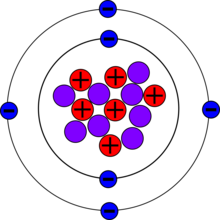 | |
| General | |
|---|---|
| Symbol | 14C |
| Names | carbon-14, 14C, C-14, radiocarbon |
| Protons (Z) | 6 |
| Neutrons (N) | 8 |
| Nuclide data | |
| Natural abundance | 1 part per trillion = |
| Half-life (t1/2) | 5700±30 years[1] |
| Isotope mass | 14.0032420[2] Da |
| Spin | 0+ |
| Decay modes | |
| Decay mode | Decay energy (MeV) |
| Beta | 0.156476[2] |
| Isotopes of carbon Complete table of nuclides | |
Carbon-14, C-14, 14C or radiocarbon, is a radioactive isotope of carbon with an atomic nucleus containing 6 protons and 8 neutrons. Its presence in organic matter is the basis of the radiocarbon dating method pioneered by Willard Libby and colleagues (1949) to date archaeological, geological and hydrogeological samples. Carbon-14 was discovered on February 27, 1940, by Martin Kamen and Sam Ruben at the University of California Radiation Laboratory in Berkeley, California. Its existence had been suggested by Franz Kurie in 1934.[3]
There are three naturally occurring isotopes of carbon on Earth: carbon-12 (12C), which makes up 99% of all carbon on Earth; carbon-13 (13C), which makes up 1%; and carbon-14 (14C), which occurs in trace amounts, making up about 1-1.5 atoms per 1012 atoms of carbon in the atmosphere. 12C and 13C are both stable; 14C is unstable, with half-life 5700±30 years.[4] Carbon-14 has a specific activity of 62.4 mCi/mmol (2.31 GBq/mmol), or 164.9 GBq/g.[5] Carbon-14 decays into nitrogen-14 (14
N) through beta decay.[6] A gram of carbon containing 1 atom of carbon-14 per 1012 atoms, emits ~0.2[7] beta (β) particles per second. The primary natural source of carbon-14 on Earth is cosmic ray action on nitrogen in the atmosphere, and it is therefore a cosmogenic nuclide. However, open-air nuclear testing between 1955 and 1980 contributed to this pool.
The different isotopes of carbon do not differ appreciably in their chemical properties. This resemblance is used in chemical and biological research, in a technique called carbon labeling: carbon-14 atoms can be used to replace nonradioactive carbon, in order to trace chemical and biochemical reactions involving carbon atoms from any given organic compound.
- ^ Kondev, F. G.; Wang, M.; Huang, W. J.; Naimi, S.; Audi, G. (2021). "The NUBASE2020 evaluation of nuclear properties" (PDF). Chinese Physics C. 45 (3): 030001. doi:10.1088/1674-1137/abddae.
- ^ a b Waptstra AH, Audi G, Thibault C. "AME atomic mass evaluation 2003". IAEA.org. Archived from the original on 5 May 2023.
- ^ Kamen MD (May 1963). "Early History of Carbon-14: Discovery of this supremely important tracer was expected in the physical sense but not in the chemical sense". Science. 140 (3567): 584–590. Bibcode:1963Sci...140..584K. doi:10.1126/science.140.3567.584. PMID 17737092.
- ^ Kondev, F.G.; Wang, M.; Huang, W.J.; Naimi, S.; Audi, G. (2021-03-01). "The NUBASE2020 evaluation of nuclear physics properties *". Chinese Physics C. 45 (3): 030001. doi:10.1088/1674-1137/abddae. ISSN 1674-1137.
- ^ Babin V, Taran F, Audisio D (June 2022). "Late-Stage Carbon-14 Labeling and Isotope Exchange: Emerging Opportunities and Future Challenges". JACS Au. 2 (6): 1234–1251. doi:10.1021/jacsau.2c00030. PMC 9241029. PMID 35783167.
- ^ "What is carbon dating?". National Ocean Sciences Accelerator Mass Spectrometry Facility. Archived from the original on July 5, 2007. Retrieved 2007-06-11.
- ^ (1 per 1012) × (1 gram / (12 grams per mole)) × (Avogadro constant) / ((5,730 years) × (31,557,600 seconds per Julian year) / ln(2))
